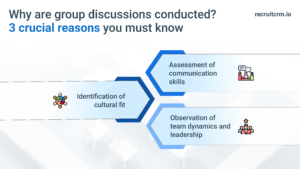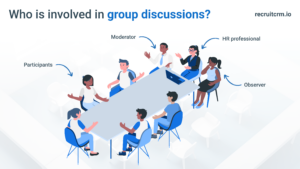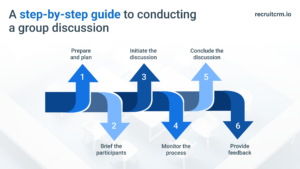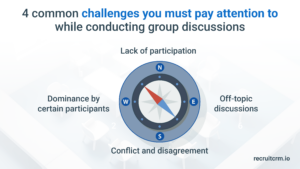Find out how recruiters can use group discussions to their advantage and spot the best talent among a pool of potential candidates.
What are group discussions?
Group discussion (GD) is an evaluation method used by recruiters during the hiring process.
It is a structured conversation where candidates participate together to discuss specific topics or scenarios relevant to the job.
The main objective of a group discussion is to assess a participant’s capability to articulate and convey their thoughts efficiently in a panel setting.
Also read: How can recruiters prepare & conduct group interviews?
Why are group discussions conducted? 3 crucial reasons you must know

While interviews provide important insights, group discussions offer a more holistic way to test candidates beyond just their technical qualifications.
There are a few key reasons why you must include GDs as part of your selection process:
1. Observation of team dynamics and leadership
Observing applicants’ solving problems together gives direct insights into how they will fit into your company culture and work within a team environment on a daily basis.
It highlights those who naturally take on leadership roles by facilitating conversation and steering the discussion towards constructive outcomes.
2. Assessment of communication skills
Group discussions provide a real-time way to evaluate a candidate’s ability to express ideas clearly and persuasively.
Unlike one-on-one interviews, where responses can be rehearsed, group discussions require participants to articulate their thoughts spontaneously and coherently.
3. Identification of cultural fit
Beyond assessing technical skills and intellectual capabilities, GDs can shed light on a candidate’s values, ethics, and compatibility with the organization’s culture.
These observations are important for maintaining a positive, productive work environment and ensuring that new hires align with the company’s core values and work ethic.
You might also like: How to hire top talent & keep it?
Who is involved in group discussions?

1. Moderator
They are the facilitators who oversee the GD to ensure that the discussion stays on topic, all participants have an opportunity to contribute, and the environment remains respectful and productive.
The moderator also introduces the topic, maintains a check on time, and may conclude the session with a summary of points discussed.
2. Candidates
These are the individuals participating in the GD, typically job applicants who are being considered for a position. They are expected to contribute to the discussion to showcase their relevant skills.
3. HR representatives
HR professionals are involved in organizing the GD, ensuring that the process aligns with the company’s hiring policies and diversity and inclusion goals.
They may also play a role in evaluating candidates, focusing on aspects like cultural fit and adherence to company values.
4. Observers
Often, there are one or more observers or evaluators present who do not participate in the discussion but are there to assess the performance of the candidates.
These evaluators are usually recruiters who take notes on each participant’s contributions, considering factors like content relevance, communication skills, leadership, and teamwork.
What are the different types of group discussions?
1. Topic-based discussions
These are the most traditional forms of GDs, where participants are given specific topics to discuss.
The topic can be of various natures—current affairs, social issues, abstract concepts, or case studies and this may depend on the job role you’re hiring for.
This type of discussion tests the applicant’s knowledge of the topic, their ability to think critically, and how well they can articulate their thoughts.
2. Case study
In this format, participants are presented with a case study that outlines a particular scenario or problem, often related to business or management issues.
The group is tasked with analyzing the case, discussing possible solutions, and coming to a consensus.
It evaluates analytical thinking, problem-solving skills, and how candidates apply their knowledge in practical situations.
3. Activity-based
Here, the group is given a task or activity to complete within a certain timeframe. The task could be anything from building a structure out of limited resources to planning a project or event.
This format assesses teamwork, leadership qualities, creativity, and the ability to work under pressure.
4. Panel discussions
Although less common in recruitment, panel discussions involve a group of experts or candidates discussing a topic in front of an audience, with a moderator facilitating the conversation.
This format is more formal and is used to assess in-depth knowledge of a subject, public speaking skills, and the ability to engage in a high-level discourse.
5. Debate-style discussions
In a debate-style GD, participants are divided into groups, with each side assigned a position to defend or argue against a specific issue or statement.
It tests persuasive skills, the ability to construct logical arguments, and handling the opposition.
Also read: Avizio now seamlessly engages with 4x candidates every week using Recruit CRM
What is the process of conducting group discussions?

Step 1: Prepare and plan
The first step involves choosing a relevant and engaging topic for discussion. The topic can vary depending on the objectives of the GD.
Make sure you’re clearly defining what the discussion aims to assess.
Decide on the format of the discussion, whether it will be free-form, a case study analysis, or a task-based activity.
Step 2: Brief the participants
Before the discussion begins, brief the participants about the rules, the topic, the time limit, and the evaluation criteria. This ensures everyone starts on equal footing and understands what is expected of them.
Step 3: Initiate the discussion
Start the GD with either a moderator introducing the topic and inviting participants to begin the discussion or by asking anyone to kickstart the conversation.
Remember, this phase is crucial to set the tone of the discussion.
Step 4: Monitor the process
Observers or recruiters monitor the discussion without participating. They note how participants contribute to the conversation, their ability to listen and respond to others, and their overall demeanor.
The focus is on assessing each candidate’s performance based on the predefined objectives.
Step 5: Conclude the discussion
The moderator or a designated participant concludes the discussion by summarizing the key points made, any consensus reached, or highlighting the diversity of opinions presented.
This step brings closure to the discussion.
Step 6: Provide feedback
After the GD, evaluators provide feedback to participants, highlighting strengths and areas for improvement. This feedback can be invaluable for candidates’ personal development.
Also read: 10 winning interview process steps for recruiters [Implement now & see results!]
4 hacks to design good topics for group discussions
1. Use abstract concepts to spark creativity
Abstract topics encourage participants to think outside the box and demonstrate their ability to construct arguments and ideas from less concrete concepts.
Some topics can be: “Is silence more powerful than words?” or “The color blue: Calmness or sadness?”
2. Encourage critical thinking
Topics like “How to combat fake news in the digital age” or “Strategies for addressing urban traffic congestion” challenge participants to analyze situations, think critically, and propose solutions.
This approach is particularly effective in evaluating their problem-solving abilities and creativity.
3. Incorporate current affairs
Next, titles that touch upon recent news, technological advancements, or global issues can stimulate dynamic discussions and provide insights into participants’ awareness and perspectives on contemporary matters.
For instance, you can use topics like “The role of social media in modern protests” or “Do you think sustainable development goals are feasible targets?”
4. Ensure relevance to the audience
Lastly, the topic should resonate with the participants’ backgrounds and the goals of the group discussion.
For a recruitment process, choose topics related to the industry, role-specific challenges, or current trends affecting the business.
For educational settings, topics might relate to recent developments in the field of study, ethical dilemmas, or theoretical concepts applied to real-world scenarios.
9 examples of relevant topics for group discussions
Here are some examples of effective and relevant topics for group discussions:
- Mental health awareness in the workplace
- AI: Boon or bane for humanity?
- The influence of social media on public opinion
- The intersection of art and tech
- E-sports: Sport or entertainment?
- Is digital detox necessary, or is it an overreaction?
- The power of influencer marketing today
- The role of tech in enhancing/diminishing human connections
- The impact of remote jobs on work productivity
6 factors to look out for while evaluating candidates during group discussions
1. Communication skills
Effective communication is paramount in group discussions. Evaluate participants based on their ability to express ideas clearly and concisely, their listening skills, and how well they respond to others’ points of view.
Pay attention to both verbal and non-verbal cues, such as body language, eye contact, and the respect shown when others are speaking.
2. Content and relevance
Assess the quality of the content shared by the candidates. This includes the relevance of their contributions to the topic, the depth of their arguments, and their ability to back up points with facts or logical reasoning.
High ratings should be given to participants who demonstrate a well-rounded understanding of the topic and bring unique insights into the discussion.
3. Leadership and initiative
Look for individuals who take the initiative to guide the discussion, introduce new ideas, and encourage participation from quieter group members.
Leadership in group discussions can also manifest as the ability to mediate conflicts, summarize points, and steer the conversation toward a productive conclusion.
4. Teamwork and collaboration
The essence of group discussions lies in collaboration.
Evaluate how candidates work within the group—are they cooperative, do they build on others’ ideas, and how do they react to differing opinions?
The ability to work harmoniously and effectively within a team, showing respect and openness to diverse perspectives, is a critical trait.
5. Adaptability and flexibility
Group discussions can take unexpected turns. Candidates who demonstrate adaptability by adjusting their viewpoints in light of new information or perspectives show a level of flexibility and open-mindedness valuable in dynamic work environments.
6. Impact and persuasiveness
Evaluate whether the candidates influence the direction or outcome of the conversation or whether they’re persuasive in their arguments without being domineering.
The ability to persuade and inspire others while maintaining a collaborative stance is a sign of effective leadership and communication skills.
Some evaluation techniques you can use are:
- Use a rating scale: Develop a consistent rating scale for each evaluation criterion to ensure objectivity and fairness in the assessment process.
- Take comprehensive notes: Observers should take detailed notes on each candidate’s performance to support their evaluations and provide feedback if necessary.
- Incorporate multiple evaluators: Having more than one evaluator can help mitigate bias and provide a more rounded view of each participant’s abilities.
Also read: Top 9 brand ambassador must-have skills
4 common challenges you must pay attention to while conducting group discussions

1. Lack of participation
Sometimes, participants may feel shy, intimidated, or unprepared, leading to uneven participation levels.
Create a supportive atmosphere that encourages everyone to share their thoughts. Use ice-breaker activities or start with less contentious topics to warm up the group.
Directly engage quieter applicants by asking for their opinions on specific points to boost confidence and involvement.
2. Conflict and disagreement
While some disagreement is healthy and promotes a deeper exploration of the topic, excessive conflict can derail the discussion and create a negative atmosphere.
Address conflicts directly but diplomatically. Acknowledge differing opinions and guide the group towards constructive debate, focusing on the issue rather than personal differences.
3. Off-topic discussions
Discussions can sometimes veer off-topic, leading to wasted time and diminished focus on the objectives.
Keep the discussion on track by gently steering the conversation back to the main topic. Summarize key points and redirect the focus to the original question or a related subject that aligns with the discussion’s goals.
4. Dominance by certain participants
Often, one or two candidates may dominate the conversation, overshadowing quieter members and skewing the evaluation process.
Encourage equal participation by gently intervening when someone dominates the discussion. Pose direct questions to quieter members or structure the discussion in a way that everyone gets a turn to speak.
Also read: Are you facing any of these 9 hiring challenges [+ Ways to tackle them]
Frequently asked questions
1. How long should group discussions last?
The ideal duration for group discussions is typically between 30 to 45 minutes. This timeframe strikes a balance, offering enough opportunity for each participant to express their views and engage with the topic without the discussion becoming too lengthy or losing focus.
Shorter discussions might not provide sufficient insight into each candidate’s abilities, while longer ones could lead to diminishing engagement or repetitive contributions.
2. Should I provide feedback to every candidate after a group discussion?
Providing individual feedback after a group discussion is essential, as it contributes significantly to the participant’s personal and professional development.
Your insights should highlight strengths and pinpoint areas for improvement, offering constructive advice that they can apply in future discussions or interviews.
This practice not only enhances the candidate experience but also reinforces the organization’s commitment to fostering growth and development.
3. What should I keep in mind when conducting group discussions for candidates?
When conducting group discussions, you should prioritize clear communication of the discussion’s objectives and rules to ensure all participants are on equal footing from the start.
It’s important to create an environment that encourages open and respectful exchange of ideas, where all voices can be heard.
Lastly, maintaining neutrality and avoiding any bias in moderating the discussion is crucial for a fair assessment of each candidate’s contributions.
4. Does group discussion differ from role to role?
Yes, the structure and focus of group discussions can vary significantly depending on the role being recruited for.
For technical positions, discussions might center around problem-solving tasks or case studies relevant to the field, assessing their analytical skills and technical knowledge.
For roles requiring strong interpersonal skills, such as sales or customer service, discussions might focus on scenarios that evaluate communication, persuasion, and conflict resolution abilities.




